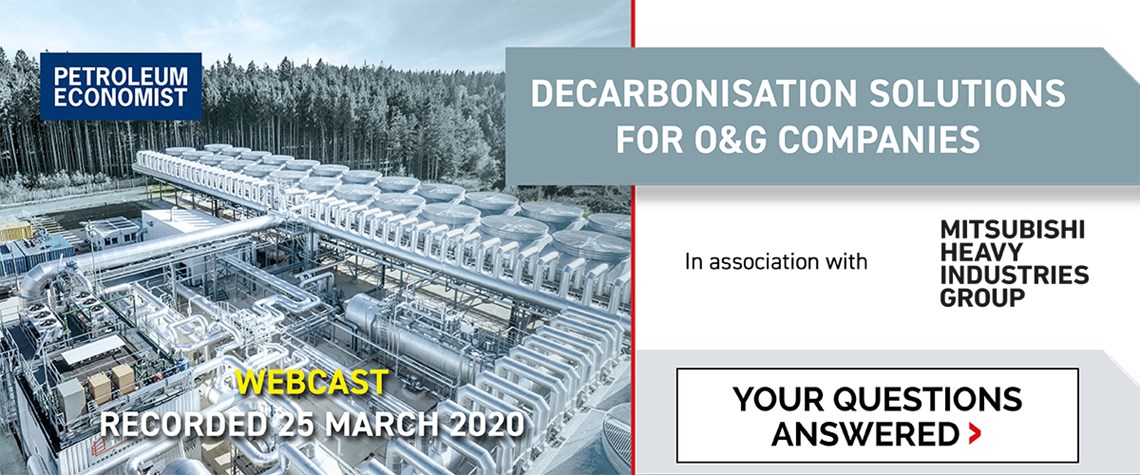Petroleum Economist in association with Turboden, a part of Mitsubishi Heavy Industries Group, hosted a webcast on decarbonisation solutions for the oil and gas sector yesterday.
Nicola Rossetti, sales & business development manager for oil & gas and combined cycle at Turboden, shared his knowledge about waste heat recovery systems.
The discussion focused on the installation of organic Rankine cycle (ORC) systems and participants put their questions to the speaker during the webcast. Questions relating to topics not covered during discussion are answered below.
The webcast is available for free on the Petroleum Economist website. Click here to listen.
Participant: Are not indirect [decarbonisation] measures more capex intensive, and that is the reason why direct ones were preferred?
Nicola Rossetti: It really depends on the specific status of the processes developed. Highly-developed processes, as most of those currently used by oil and gas industries, already include most of the low-capex direct methods.
Further direct CO2 reduction methods require specific technological efforts and consequently these are more capex intensive than indirect methods.
Participant: In your opinion, how can governments help to implement carbon capture technologies? Which kind of incentives and measures?
Rossetti: Countries play a key role in encouraging the development of energy efficiency projects within industries. However, this does not necessary mean incentives.
First of all, legislation should not erect barriers to the development of solutions. Unfortunately, certain regulations essentially do not allow the development of CO2 reduction methods, especially indirect ones. One example is the EU legislation that imposes limits on electrical energy produced by gas transmission and distribution companies, even if the production comes from energy efficiency projects.
Once these barriers are overcome, countries could develop further measures such as incentives to energy efficiency solutions. In some countries, there are already similar incentives like the ‘white certificates’ in Italy.
Participant: Can ORC be retrofitted to existing facilities and/or added into the facilities while they are built from scratch? Is the recovery of waste heat more suitable for new (greenfield) capex projects or can they also be easily implemented in an economic way in existing facilities?
Rossetti: Heat recovery projects developed in greenfield projects can be developed in a more effective manner, reducing the capex of the heat recovery system. However, thanks to the fact that the ORC technology is highly flexible, it is possible to implement waste heat recovery projects in existing facilities while still maintaining a good capex level.
Specifically, ORC requires low temperature and pressure to achieve a good efficiency, therefore it is possible to implement a heat carrier system to transport the energy from the source to the ORC. In addition, as ORC is not heavily affected by waste heat load variation, it can be easily coupled with existing processes without impacting their operation—instead actually following them.
Participant: What is the thermal/power rating of a Turboden ORC unit from one typical gas turbine for compressor engine? What is the range from minimum to maximum? What is the efficiency of ORC?
Rossetti: The thermal/electric power rating of the ORC system highly depends on the temperatures of the heat and cold source. Since in most of the cases the cold source is ambient air, there is actually a relation between the two sources. In fact, the higher the ambient air temperature, the higher the gas turbine exhaust’s temperature.
We can summarise that, for heat recovery from gas turbines, the ORC efficiency (the ratio between electric output and thermal input) ranges from 22pc to 27pc. The lower efficiency number applies in extremely hot climates while higher efficiency occurs in cold climates (not extremely cold or there would be a negative impact due to too low exhaust gas temperatures).
Participant: Too much backpressure could decrease performance and damage equipment. What type of backpressure does this place on the exhaust stack?
Rossetti: The heat recovery exchangers bottoming the gas turbines are designed in order to have an overall (including the diverter valve and the by-pass ducting) backpressure induced lower than 250mmH2O; this value, has a negligible impact on most manufacturers’ gas turbines’ efficiency.
Participant: What is the name of the fluid used in ORC?
Rossetti: Depending on the source temperature, different fluids can be used—from hydrocarbons for high temperature applications to refrigerants used for low temperature applications. In the specific case of heat recovery from gas turbines, typically pentane (either isopentane, n-pentane or cyclopentane depending on the project’s peculiarities) is used as ORC working fluid.
Participant: Please clarify the power production reference case [slide 15 in the webcast]. Does two operational turbines and one on standby imply two Turboden units (where flue gas piping goes from three turbines to two Turboden units)? Or are your cost figures based on three Turboden units?
Rossetti: Thanks to the fact that the ORC systems have a wide operational range—from 10pc to 110pc of the nominal load—when more gas turbines are present, typically the heat recovery systems foresees a heat recovery exchanger installed on each gas turbine and a single heat carrier loop to convey the heat from the different sources (different gas turbines) to a single ORC unit.
This configuration allows both a reduction of the overall capex of the project and to keep the heat recovery system in operation independently from the gas turbines load.
Participant: How does feasibility change depending on the facility location?
Rossetti: The facility’s location has two main impacts on a project’s feasibility. Firstly, the site’s location and its accessibility has an effect on the project’s capex.
Secondly, the ambient conditions at the location, especially the air temperature, has an impact on the ORC system’s power output and consequently on the producible electricity. The higher the air temperature, the lower the ORC system’s power output.
Participant: Can you provide any information on CCUS and decarbonisation of hard to abate industries?
Rossetti: Sure, Mitsubishi Heavy Industries Group has produced an article that includes information on ORC technology as well as CCUS and hydrogen. You can read the piece here.








Comments